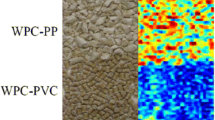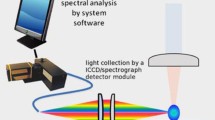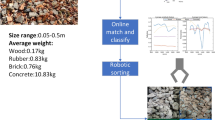Abstract
To implement the discovery of discarded anti-corrosion wood, an automatic sorting robot system was built. Three kinds of commonly used wood were selected as the research object, which uses hyperspectral imaging technology to achieve the identification. In the range of 900–1700 nm (230 bands), the infrared spectra of three kinds of anti-corrosion wood were collected, and then the characteristic information was obtained through the analysis of MATLAB to distinguish them. Among them, three kinds of preservative woods are Scots pine (add CCA treatment), Pseudotsuga menziesii (high-temperature carbonization treatment) and Incense Cedar (pressurized treatment). After the pretreatment by the Savitzky-Golay method, spectral data were conducted by principal component analysis (PCA), and the contribution rate of the first three principal components reached 99.902 %. Besides, through the loading coefficients of the first three principal components that were plotted on the wavelength, we obtained five characteristic wavelengths and corresponding reflectance information, simultaneously; this set up a typical discriminant analysis model. Then, the model was validated by the validation set, and the accuracy rate of the prediction set was 98.89 %. This method can effectively identify and classify three kinds of anti-corrosion wood, which can provide a scientific method and basis for a solid waste sorting system.
Similar content being viewed by others
Abbreviations
- R :
-
Calibrated hyperspectral image
- W :
-
White calibration i mage
- B :
-
Black calibration i mage
- R o :
-
Original i mage
- W 0 :
-
Weight vector or coefficient vector
- W n+1 :
-
Constant
- W = (w1,w2,…,Wn+1):
-
Augmented weight vector
- X′ = (X1,X2,…,Xn,1)T :
-
Augmented feature vector
- r1, r2, r3 :
-
The identification radius
- d1,d2,d3 :
-
The distance
References
X. X. Wang and Z. J. Zhang, Application and development of antiseptic wood in urban landscape of China, Ningxia Agricultural and Forestry Science and Technology, 57(6) (2016) 46–49.
G. Bonifazi et al., Hyperspect ral imaging as a technique for investigating the effect of consolidating materials on wood, J. of Electronic Imaging, Springfield, USA, 26 (1) (2017).
G. Bonifazi et al., A new approach for the modeling of chestnut wood photo-degradation monitored by different spectroscopic techniques, Environmental Science and Pollution Research, 24(16) (2017) 13874–13884.
M. Manley, Near-infrared spectroscopy and hyperspectral imaging: Non-destructive analysis of biological materials, Chemical Society Reviews, 43(24) (2014) 8200–8214.
Y. H. Liu et al., Potential of hyperspec tral imaging for rapid prediction of anthocyanin content of purple fleshed sweet potato slices during drying process, Food Analytical Methods, 10(10) (2017) 1–11.
D. Mauruschat et al., Application of near-infrared spectroscopy for the fast detection and sorting of wood-plastic composites and waste wood treated with wood preservatives, Wood Science and Technology, 50(2) (2016) 313–331.
Q. Q. Ni et al., Identification of red-acid branch wood species based on hyperspectral imaging technique, J. of Zhejiang A&F University, 33(3) (2016) 489–494.
W. C. Guo and J. L. Dong, Non-destructive detection of peach hardness based on hyperspectral imaging combined with the artificial neural network, Optical Precision Engineering, 23(6) (2015) 1530–1537.
Z. Wang and Z. H. Wang, Design and research of automatic loading and unloading manipulator for slate, Digital Manufacturing Science, 17(3) (2019) 216–220.
B. He et al., Mobility properties analyses of a wall climbing hexapod robot, Journal of Mechanical Science and Technology, 32(3) (2018) 1333–1344.
H. Zhang, Study on Grasping Performance of Pneumatic Soft Manipulator, Xi’an University of Technology (2019).
E. Kibirkstis et al., Synchronization of pneumatic vibroexciters operating on air cushion with feeding pulsatile pressure under autovibration regime Postharvest, Journal of Mechanical Science and Technology, 32(1) (2018) 81–89.
Y. D. Bao et al., Rapid identification of domestic varieties of coffee beans by near-infrared hyperspectral imaging technology, Optical Precision Engineering, 23(2) (2015) 349–355.
P. J. D. Groot et al., Validation of remote, on-line, near-infrared measurements for the classification of demolition waste, Analytica Chimica Acta, 453(1) (2002) 117–124.
D. Tuia, R. Flamary and N. Courty, Multiclass feature learning for hyperspectral image classification: Sparse and hierachical solutions, Isprs J. of Photogrammetry and Remote Sensing, 105 (2015) 272–285.
M. Kamruzzaman et al., Fast detection and visualization of minced lamb meat adulteration using NIR hyperspectral imaging and multivariate image analysis, Talanta, 103(2) (2013) 130–136.
S. Bach et al., On pixel-wise explanations for non-linear classifier decisions by layer-wise relevance propagation, Plos One, 10 (7) (2015).
Y. C. Chou et al., Comparison of self-determination of students with disabilities: Multivariate and discriminant function analyses, J. of Intellectual Disability Research: JIDR, 61(2) (2017) 144–154.
K. R. Ostrofsky and S. E. Churchill, Sex determination by discriminant function analysis of lumbar vertebrae, J. of Forensic Sciences, 60(1) (2014) 21–28.
T. Charoenpong et al., Pupil extraction system for Nystagmus diagnosis by using K-mean clustering and Mahalanobis distance technique, International Conference on Knowledge and Smart Technology, IEEE (2012) 24–29.
H. J. Lin et al., Mahalanobis distance-based hyperspectral characteristic discrimination of leaves of different desert tree species, Spectroscopy and Spectral Analysis, 34(12) (2014) 3358–3362.
Acknowledgments
This research is supported by the “Quanzhou science and technology project” (project No. 2018Z001), Fujian Provincial Natural Science Foundation-funded projects (No. 2017J01086 and No. 2016J01236), and National Natural Science Foundation of China (No. 51505161 and No. 61603144).
Author information
Authors and Affiliations
Corresponding author
Additional information
Recommended by Editor Ja Choon Koo
Huaxue Jin is studying for the M.S. at Huaqiao University Xiamen City, Fujian Province, China. Her main research direction is micro/nano drive.
Wei Fan began teaching at Huaqiao University-Xiamen after obtaining his doctorate from Hefei University of Technology. And he has obtained the title of Associate Professor in same university. His main research direction is micro/nano drive.
Rights and permissions
About this article
Cite this article
Jin, H., Fan, W., Chen, H. et al. Anti-corrosion wood automatic sorting robot system based on near-infrared imaging technology. J Mech Sci Technol 34, 3049–3055 (2020). https://doi.org/10.1007/s12206-020-0636-z
Received:
Revised:
Accepted:
Published:
Issue Date:
DOI: https://doi.org/10.1007/s12206-020-0636-z




